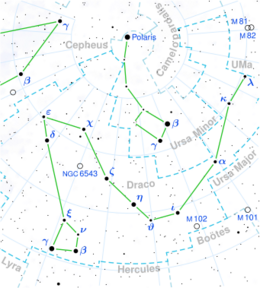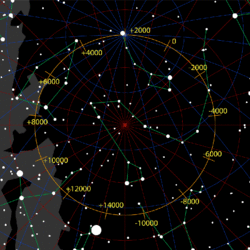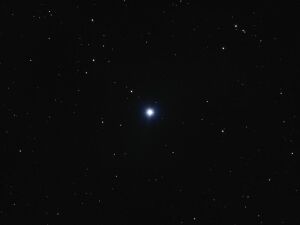Thuban
Topic: Astronomy
 From HandWiki - Reading time: 6 min
From HandWiki - Reading time: 6 min
| Observation data Equinox J2000.0]] (ICRS) | |
|---|---|
| Constellation | Draco |
| Right ascension | 14h 04m 23.3500s[1] |
| Declination | 64° 22′ 33.062″[1] |
| Apparent magnitude (V) | 3.67[2] |
| Characteristics | |
| Spectral type | A0IV + A1V[3] |
| U−B color index | −0.08 |
| B−V color index | −0.049±0.005[2] |
| Variable type | suspected Maia[4] |
| Astrometry | |
| Radial velocity (Rv) | −13.0 km/s |
| Proper motion (μ) | RA: −56.34[1] mas/yr Dec.: 17.21[1] mas/yr |
| Parallax (π) | 10.76 ± 0.17[1] mas |
| Distance | 303 ± 5 ly (93 ± 1 pc) |
| Absolute magnitude (MV) | −1.20[5] |
| Orbit[3] | |
| Period (P) | 51.417350 d |
| Semi-major axis (a) | 5.52 mas |
| Eccentricity (e) | 0.43 |
| Inclination (i) | 85.4° |
| Longitude of the node (Ω) | 252.6° |
| Periastron epoch (T) | JD 2453498.8 |
| Argument of periastron (ω) (secondary) | 22.4° |
| Semi-amplitude (K1) (primary) | 48.512 km/s |
| Semi-amplitude (K2) (secondary) | 63.58 km/s |
| Details[3] | |
| α Draconis A Alpha Draconis A | |
| Mass | 3.186 M☉ |
| Radius | 4.932 R☉ |
| Luminosity | 240 L☉ |
| Surface gravity (log g) | 3.555 cgs |
| Temperature | 10225 K |
| Rotational velocity (v sin i) | 25.4 km/s |
| Age | 280 Myr |
| α Draconis B Alpha Draconis B | |
| Mass | 2.431 M☉ |
| Radius | 2.326 R☉ |
| Luminosity | 47.5 L☉ |
| Surface gravity (log g) | 4.090 cgs |
| Temperature | 9930 K |
| Rotational velocity (v sin i) | 168 km/s |
| Age | 345 Myr |
| Other designations | |
| Database references | |
| SIMBAD | data |
Thuban (/ˈθjuːbæn/),[6] with Bayer designation Alpha Draconis or α Draconis, is a binary star system in the northern constellation of Draco. A relatively inconspicuous star in the night sky of the Northern Hemisphere, it is historically significant as having been the north pole star from the 4th to 2nd millennium BC.
Johann Bayer gave Thuban the designation Alpha and placed it as the only member of his secundae magnitude class in Draco, although its current apparent magnitude of 3.65 means it is 3.7 times fainter than the brightest star in the constellation, Gamma Draconis (Eltanin), which Bayer placed in his tertiae magnitude class although its current apparent magnitude is 2.24.[7]
Nomenclature
α Draconis (Latinised to Alpha Draconis) is the star's Bayer designation.
The traditional name Thuban is derived from the Arabic word ثعبان thuʿbān ('large snake' (e.g. a python or a legendary draconian serpent)). It is sometimes known as the Dragon's Tail and as Adib /əˈdiːb/.[6] In 2016, the International Astronomical Union organized a Working Group on Star Names (WGSN)[8] to catalog and standardize proper names for stars. The WGSN's first bulletin of July 2016[9] included a table of the first two batches of names approved by the WGSN; which included Thuban for this star. It is now so entered in the IAU Catalog of Star Names.[10]
In Chinese, 紫微右垣 (Zǐ Wēi Yòu Yuán), meaning Right Wall of Purple Forbidden Enclosure, refers to an asterism consisting of Alpha Draconis, Kappa Draconis, Lambda Draconis, 24 Ursae Majoris, 43 Camelopardalis, Alpha Camelopardalis and BK Camelopardalis.[11] Consequently, the Chinese name for Alpha Draconis itself is 紫微右垣一 (Zǐ Wēi Yòu Yuán yī, English: the First Star of Right Wall of Purple Forbidden Enclosure),[12] representing 右樞 (Yòushū), meaning Right Pivot.[13]
Visibility
Given good viewing conditions, Thuban is relatively easy to spot in the night sky, due to its location in relation to the Big Dipper (aka the Plough) asterism of Ursa Major. While it is well known that the two outer stars of the 'dipper' point to the modern-day pole star Polaris, it is less well known that the two inner stars, Phecda and Megrez, point to Thuban, just 15 degrees of arc from Megrez. Thuban is not bright enough to be viewed from badly light-polluted areas.
Pole star
Due to the precession of Earth's rotational axis, Thuban was the naked-eye star closest to the north pole from 3942 BC, when it superseded Tau Herculis as the pole star, until 1793 BC, when it was superseded by Kappa Draconis. It was closest to the pole in 2830 BC, when it was less than 10 arcminutes away from the pole.[14] It remained within one degree of celestial north for nearly 200 years afterwards, and even 900 years after its closest approach, was just 5° off the pole. Thuban was considered the pole star until about 1800 BC, when the much brighter Beta Ursae Minoris (Kochab) began to approach the pole as well.
Having gradually drifted away from the pole over the last 4800 years, Thuban is now seen in the night sky at a declination of 64° 20′ 45.6″, RA 14h 04m 33.58s. After moving nearly 47° off the pole by 10,000 AD, Thuban will gradually move back toward the north celestial pole. In 20,346 AD, it will again be the pole star, that year reaching a maximum declination of 88° 43′ 17.3″, at right ascension 19h 08m 54.17s.[citation needed]
| Preceded by | Pole star | Succeeded by |
|---|---|---|
| Tau Herculis | c. 3900–1800 BC | Kochab |
Binary system

Thuban is a single-lined spectroscopic binary. For a long time, only the primary star could be detected in the spectrum. The radial velocity variations of the stars can be measured and the pair have a somewhat eccentric orbit of 51.4 days.[3] The secondary is a main-sequence star slightly cooler than the primary, with an A1 spectral class.[3]
The secondary star was detected in high spatial resolution observations using the Navy Precision Optical Interferometer. The secondary star is 1.8 magnitudes (at 700 nm) fainter than the primary star and was detected at separations ranging from 6.2 to 2.6 milliarcseconds.[16] Eclipses were detected using data obtained with the Transiting Exoplanet Survey Satellite (TESS).[17] The presence of eclipses places Thuban into the class of binaries known as eclipsing binaries.[3]
Properties
Thuban has a spectral class of A0III, indicating its similarity to Vega in temperature and spectrum, but more luminous and more massive. It has been used as an MK spectral standard for the A0III type.[18]
Thuban is not a main-sequence star; it has now ceased hydrogen fusion in its core. That makes it a white giant star, being 120 times more luminous than the Sun. It is 300 light-years away and its brightness is only decreased by 0.003 of a magnitude by intervening gas and dust.[5]
Conspiracy theory
According to British conspiracy theorist David Icke, Alpha Draconis is the origin of blood-drinking, shape-shifting reptilians who lurk in underground bases on Earth and plot against humanity (with the aid of powerful figures including royalty).[19]
References
- ↑ 1.0 1.1 1.2 1.3 1.4 Van Leeuwen, F. (2007). "Validation of the new Hipparcos reduction". Astronomy and Astrophysics 474 (2): 653–664. doi:10.1051/0004-6361:20078357. Bibcode: 2007A&A...474..653V.
- ↑ 2.0 2.1 Anderson, E.; Francis, Ch. (2012), "XHIP: An extended hipparcos compilation", Astronomy Letters 38 (5): 331, doi:10.1134/S1063773712050015, Bibcode: 2012AstL...38..331A.
- ↑ 3.0 3.1 3.2 3.3 3.4 3.5 Pavlovski, K.; Hummel, C. A.; Tkachenko, A.; Dervişoğlu, A.; Kayhan, C.; Zavala, R. T.; Hutter, D. J.; Tycner, C. et al. (2022). "Dynamical parallax, physical parameters, and evolutionary status of the components of the bright eclipsing binary α Draconis". Astronomy & Astrophysics 658: A92. doi:10.1051/0004-6361/202142292. Bibcode: 2022A&A...658A..92P.
- ↑ Kallinger, T.; Iliev, I.; Lehmann, H.; Weiss, W. W. (2005). "The puzzling Maia candidate star α Draconis". Proceedings of the International Astronomical Union 2004: 848–852. doi:10.1017/S1743921305009865. Bibcode: 2004IAUS..224..848K.
- ↑ 5.0 5.1 Murphy, Simon J.; Paunzen, Ernst (2017). "Gaia's view of the λ Boo star puzzle". Monthly Notices of the Royal Astronomical Society 466 (1): 546. doi:10.1093/mnras/stw3141. Bibcode: 2017MNRAS.466..546M.
- ↑ 6.0 6.1 Kunitzsch, Paul; Smart, Tim (2006). A Dictionary of Modern star Names: A Short Guide to 254 Star Names and Their Derivations (2nd rev. ed.). Cambridge, Massachusetts: Sky Pub. ISBN 978-1-931559-44-7.
- ↑ Johann Bayer (1603). Uranometria: Omnivm Asterismorvm Continens Schemata, Nova Methodo Delineata, Aereis Laminis Expressa. https://books.google.com/books?id=ivZeAAAAcAAJ.
- ↑ "IAU Working Group on Star Names (WGSN)". https://www.iau.org/science/scientific_bodies/working_groups/280/.
- ↑ "Bulletin of the IAU Working Group on Star Names, No. 1". http://www.pas.rochester.edu/~emamajek/WGSN/WGSN_bulletin1.pdf.
- ↑ "IAU Catalog of Star Names". http://www.pas.rochester.edu/~emamajek/WGSN/IAU-CSN.txt.
- ↑ (in Chinese) 中國星座神話, written by 陳久金. Published by 台灣書房出版有限公司, 2005, ISBN:978-986-7332-25-7.
- ↑ (in Chinese) 香港太空館 - 研究資源 - 亮星中英對照表 , Hong Kong Space Museum. Retrieved 2010-11-23.
- ↑ (in Chinese) English-Chinese Glossary of Chinese Star Regions, Asterisms and Star Name , Hong Kong Space Museum. Retrieved 2010-11-23.
- ↑ Moore, Patrick (1998). The Observer's Year. doi:10.1007/978-1-4471-3613-2. ISBN 978-3-540-76147-1. https://archive.org/details/observersyear36600moor.
- ↑ "MAST: Barbara A. Mikulski Archive for Space Telescopes". Space Telescope Science Institute. https://mast.stsci.edu/portal/Mashup/Clients/Mast/Portal.html.
- ↑ Hutter, D. J.; Zavala, R. T.; Tycner, C.; Benson, J. A.; Hummel, C. A.; Sanborn, J.; Franz, O. G.; Johnston, K. J. (2016-11-01). "Surveying the Bright Stars by Optical Interferometry. I. A Search for Multiplicity among Stars of Spectral Types F-K". The Astrophysical Journal Supplement Series 227 (1): 4. doi:10.3847/0067-0049/227/1/4. ISSN 0067-0049. Bibcode: 2016ApJS..227....4H.
- ↑ Bedding, Timothy R.; Hey, Daniel R.; Murphy, Simon J. (2019-10-31). "A Dance with Dragons: TESS Reveals α Draconis is a Detached Eclipsing Binary" (in en). Research Notes of the AAS 3 (10): 163. doi:10.3847/2515-5172/ab5112. ISSN 2515-5172. Bibcode: 2019RNAAS...3..163B.
- ↑ Morgan, W. W.; Abt, Helmut A.; Tapscott, J. W. (1978). "Revised MK Spectral Atlas for stars earlier than the sun". Williams Bay: Yerkes Observatory. Bibcode: 1978rmsa.book.....M.
- ↑ Hockney, Mike (2013). All The Rest is Propaganda. Hyperreality Books. p. 161. ISBN 9781326016388. https://books.google.com/books?id=BGFdCAAAQBAJ&pg=PT161. Retrieved September 13, 2017.[yes|permanent dead link|dead link}}]
External links
- Jim Kaler's Stars, University of Illinois: THUBAN (Alpha Draconis)
- NASA's: History of Precession
- : Precession of the Equinoxes
Coordinates: ![]() 14h 04m 23.3498s, +64° 22′ 33.062″
14h 04m 23.3498s, +64° 22′ 33.062″
 |
 KSF
KSF


